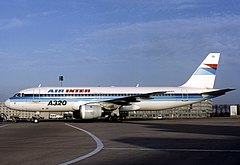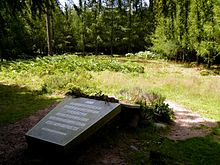Air Inter Flight 148
You can help expand this article with text translated from the corresponding article in French. (December 2018) Click [show] for important translation instructions.
|
 F-GGED, the aircraft involved in the accident, seen in January 1991 | |
| Accident | |
|---|---|
| Date | 20 January 1992 |
| Summary | Controlled flight into terrain due to ATC error and pilot error; poor training and safety standards |
| Site | Mont Sainte-Odile, west of Barr, 10.5nm S/W of Strasbourg Airport, Strasbourg, France[1] 48°25′31″N 007°24′18″E / 48.42528°N 7.40500°E |
| Aircraft | |
| Aircraft type | Airbus A320-111 |
| Operator | Air Inter |
| IATA flight No. | IT5148 |
| ICAO flight No. | ITF148DA |
| Call sign | AIR INTER 148 DELTA ALPHA[1] |
| Registration | F-GGED |
| Flight origin | Lyon Satolas Airport, Lyon, France |
| Destination | Strasbourg Airport, Strasbourg, France |
| Occupants | 96 |
| Passengers | 90 |
| Crew | 6 |
| Fatalities | 87 |
| Injuries | 9 |
| Survivors | 9 |

Air Inter Flight 148 (officially Flight 5148[a]) was a scheduled passenger flight from Lyon-Saint-Exupéry Airport (formerly known as Lyon Satolas Airport) to Strasbourg Airport in France. On 20 January 1992, the Airbus A320 operating the flight crashed into the slopes of the Vosges Mountains, France, near Mont Sainte-Odile, while on a non-precision approach at Strasbourg Airport. A total of 87 of the 96 people on board were killed, while the remaining 9 were all injured.[1][2]
Accident
[edit]Flight 148, commanded by 42-year-old Captain Christian Hecquet, with 8,800 flight hours including 162 flight hours on A320, and 37-year-old First Officer Joël Cherubin, with 3,600 flight hours including 61 hours on A320.[3] departed Lyon-Satolas (now called Lyon-Saint-Exupéry Airport) at 17:20 UTC. Both pilots were relatively new to the A320 with a combined total of only 300 hours in the aircraft,[1] but both were familiar with Strasbourg Airport as both had flown into the airport many times.
As the flight neared Strasbourg Airport, they informed ATC of their desire to follow the ILS approach for Runway 23 until the airport was in sight, followed by a visual approach onto Runway 05. This type of approach onto Runway 05 was common at Strasbourg Airport;[1] being near mountains and high terrain, Runway 05 was not equipped with ILS since the high terrain would interfere with the glide slope signal transmitted by the ILS. ATC denied the pilots approach request, saying there would be a significant delay because of conflict with several aircraft departing on Runway 05 and instead offered vectors for the VOR/DME approach for Runway 05, which the pilots accepted. The flight was cleared to descend to 5,000ft and vectored to the ANDLO waypoint 11 nautical miles from the Strasbourg Airport VOR. ATC cleared the aircraft onto the final approach at 18:19 UTC as it passed ANDLO, where the pilots turned left onto the runway heading of 050 degrees and continued to descend as per the approach chart.
At 18:20:33 UTC, Flight 148 crashed into the slopes of Mont Sainte-Odile at 2,620ft, 10.5 nautical miles from the airport. The search and rescue operation commenced at 18:40. 3 helicopters, 24 motorcycles, and 950 people from the Police Nationale, National Gendarmerie, Sécurité Civile, as well as 24 amateur radio operators participated in the search and rescue operation.[1] Although almost 1000 people were involved in the search effort, it was criticised for being unprepared and disorganised as it was not clear which of the 3 agencies would lead the search, hampering the search and rescue effort. The crash site was not discovered until 22:35 UTC (4 hours and 15 minutes later) when a group of journalists were led to the wreckage by a surviving passenger, Nicolas Skourias. The first rescuers, a group of Gendarmes, arrived at 22:49 after being led to the wreckage by the same survivor and a journalist.
The Bureau of Enquiry and Analysis for Civil Aviation Safety (BEA) found that Flight 148 crashed because the pilots left the autopilot set in Vertical Speed Mode instead of Flight Path Angle Mode and then set "33" for "3.3° descent angle", resulting in a high descent rate of 3,300 ft (1,000 m) per minute into terrain.[1]
The pilots had no warning of the imminent impact because Air Inter had not equipped its aircraft with a ground proximity warning system (GPWS). It is speculated that this was because Air Inter—facing ferocious competition from France's TGV high-speed trains—may have encouraged its pilots to fly fast at low level (up to 350 kn [650 km/h; 400 mph] below 10,000 ft [3,000 m], while other airlines generally do not exceed 250 kn [460 km/h; 290 mph]), and GPWS systems gave too many nuisance warnings.[4]
Aircraft
[edit]The aircraft involved, manufactured in 1988, was an Airbus A320-111 registered as F-GGED with serial number 015. At the time of the accident, the aircraft had accumulated a total of 6,316 airframe hours and 7194 takeoff and landing cycles.[5][6]
Aftermath
[edit]
Accident investigators recommended 35 changes in their report. Airbus modified the interface of the autopilot so that a vertical speed setting would be displayed as a four-digit number, preventing confusion with the Flight Path Angle mode.[7] The flight data recorder was upgraded so that it was able to withstand higher temperatures and for longer.[1][4] The report also recommended that pilot training for the A320 should be enhanced and that ground proximity warning systems should be installed on them. Air Inter equipped its aircraft with ground proximity warning systems before the investigation was completed.[1][8][9]
Dramatization
[edit]The story of the disaster was featured on the ninth season of Cineflix television show Mayday in the episode entitled "The Final Blow" (also known as Air Crash Investigation as episode entitled "Crashed and Missing" or "Doomed to Fail" (S09E07)).[4]
It is featured in season 2, episode 5, of the TV show Why Planes Crash, in an episode called "Sudden Impact".[citation needed]
Notes
[edit]- ^ Although the IATA flight number is IT5148, this incident is informally and widely known as Flight 148
References
[edit]- ^ a b c d e f g h i "Rapport de la commission d'enquête sur l'accident survenu le 20 janvier 1992 près du Mont Sainte-Odile (Bas Rhin) à l'Airbus A 320 immatriculé F-GGED exploité par la compagnie Air Inter" [Report of the commission of inquiry into the accident on 20 January 1992 near Mont Sainte-Odile (Bas Rhin) to the Airbus A 320 registered F-GGED operated by Air Inter] (in French). Bureau of Enquiry and Analysis for Civil Aviation Safety. Archived from the original on 13 June 2012. Retrieved 14 April 2010.
- ^ Ranter, Harro. "ASN Aircraft accident Airbus A320-111 F-GGED Strasbourg-Entzheim Airport (SXB)". aviation-safety.net. Aviation Safety Network. Archived from the original on 18 March 2005. Retrieved 1 November 2019.
- ^ "Quatorze ans après, les causes de la catastrophe du mont Sainte-Odile restent incertaines" [Fourteen years later, the causes of the Mont Sainte-Odile disaster remain uncertain]. Le Monde (in French). 2 May 2006. Retrieved 14 April 2010.
- ^ a b c "The Final Blow". Mayday. Season 9. 2010. Discovery Channel Canada / National Geographic Channel.
- ^ "OFFICIAL REPORT into the accident on 20 January 1992 near Mont Sainte-Odile (Bas-Rhin) of the AIRBUS A320 registered F-GGED operated by Air Inter [English translation]" (PDF). Bureau of Enquiry and Analysis for Civil Aviation Safety. 26 November 1993. Archived (PDF) from the original on 22 September 2018. Retrieved 1 July 2019 – via Aviation Safety Network.
- ^ "Accident Airbus A320-111 F-GGED, Monday 20 January 1992". asn.flightsafety.org. Retrieved 1 August 2024.
- ^ Johnson, Eric N.; Pritchett, Amy R. (March 1995). "DSpace@MIT: Experimental Study of Vertical Flight Path Mode Awareness". Dspace.mit.edu. Massachusetts Institute of Technology. hdl:1721.1/35913. Archived from the original on 21 May 2012. Retrieved 8 February 2014.
- ^ Turner, Aimée (31 October 2006). "Air France CEO Jean-Cyril Spinetta defends rejection of GPWS equipment on Air Inter A320 fleet, despite fatal 1992 St Odile mountainside crash". Flightglobal.com. Flight International. Retrieved 1 November 2019.
- ^ Wastnage, Justin (25 October 2006). "Video: January 1992 Air Inter Mt Saint Odile crash manslaughter verdict expected 7 November in Colmar". Flightglobal.com. Flight International. Retrieved 1 November 2019.
External links
[edit]- Bureau of Enquiry and Analysis for Civil Aviation Safety
- "RAPPORT de la commission d'enquête sur l'accident survenu le 20 janvier 1992 près du Mont Sainte-Odile (Bas Rhin) à l'Airbus A 320 immatriculé F-GGED exploité par la compagnie Air Inter. [REPORT of the Commission of Inquiry on into the accident on 20 January 1992 near Mont Sainte-Odile (Bas-Rhin) of the AIRBUS A320 registered F-GGED operated by the company Air Inter]" (in French) (Archive)
- PDF version (in French)
- Text version of final report at the University of Bielefeld (in French)
- CVR recording on YouTube
- Airliner accidents and incidents caused by pilot error
- Airliner accidents and incidents involving controlled flight into terrain
- Aviation accidents and incidents in France
- Accidents and incidents involving the Airbus A320
- Aviation accidents and incidents in 1992
- Airliner accidents and incidents caused by design or manufacturing errors
- Air Inter accidents and incidents
- January 1992 events in Europe
- Aviation accidents and incidents caused by air traffic controller error
